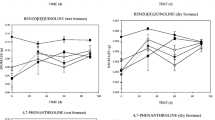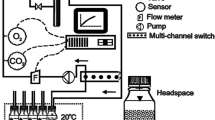Abstract
Petroleum hydrocarbon contamination of soil is an emerging environmental threat on the Earth due to possible toxic impact on different ecological receptors. The present study was mainly carried out to evaluate the phytotoxicity of long-term total petroleum hydrocarbon-contaminated soils by the toxicity end points obtained from three plant species Zea mays, Lactuca sativa L., and Cucumis sativus. The tested soil exerted phytotoxicity for all the evaluated end points of plants with dose-dependent relationship. The determined IC50 indicates inhibition in root elongation as the most sensitive toxicity end point for L. sativa L., while inhibition in cross-section area of meristematic zone as the most susceptible and inhibition in seed germination as the least susceptible end points for both Z. mays and C. sativus. The tested root morphometric parameters confirm their applicability as novel toxicity end points. In addition, microcalorimetric analysis confirmed the applicability of inhibition in metabolic heat emission rate as a toxicity end point. Microcalorimetry can be applied to determine the exerted phytotoxic effect on seedlings. The present combined approach concludes that the phytotoxicity of the tested soil is species-specific and varies as follows: Z. mays < C. sativus < L. sativa L. The findings of this study may have implications in planning comprehensive phytotoxicity assessment for hydrocarbon-contaminated soils or screening plant species for phytoremediation program.




Similar content being viewed by others
References
Adam, G., & Ducan, H. J. (2002). Influence on diesel fuel on seed germination. Environmental Pollution, 120, 363–370.
Al-Mutairi, N., Bufarsan, A., & Al-Rukaibi, F. (2008). Ecorisk evaluation and treatability potential of soils contaminated with petroleum hydrocarbon based fuels. Chemosphere, 74, 142–148.
Andreoni, V., Cavalca, L., Rao, M. A., Nocerino, G., Bernasconi, S., Della Mico, E., Colombo, M., & Gianfreda, L. (2004). Bacterial communities and enzyme activities of PAHs polluted soil. Chemosphere, 57, 401–412.
Banks, M. K., & Schultz, K. E. (2005). Comparison of plants for germination toxicity tests in petroleum-contaminated soils. Water, Air, and Soil Pollution, 167, 211–219.
Bewley, J. D., & Black, M. (1994). Seeds: physiology of development and germination. New York: Plenum.
Bojes, H. K., & Pope, P. G. (2007). Characterization of EPA’s 16 priority pollutants polycyclic aromatic hydrocarbons (PAHs) in tank bottom solid and associated contaminated soils at oil exploration and production sites in Texas. Regulatory Toxicology and Pharmacology, 47, 288–295.
Cosgrove, D. J. (1997). Relaxation in a high-stress environment-the molecular bases of extensible cell walls and cell enlargement. The Plant Cell, 9, 1031–1041.
Criddle, R. S., & Hansen, L. D. (1999). Calorimetric methods for analysis of plant metabolism. In R. B. Kemp (Ed.), Handbook of thermal analysis of plant metabolism (pp. 711–763). Amsterdam: Elsevier.
Dorn, P. B., Salanitro, J. P., & Wisniewski, H. L. (1998). Assessment of the acute toxicity of crude oils in soils using earthworms, microtox, and plants. Chemosphere, 37, 845–860.
Edelstein, M., Bradford, K. J., & Burger, D. W. (2001). Metabolic heat and CO2 production rates during germination of melon (Cucumis melo L.) seeds measured by microcalorimetry. Seed Science Research, 11, 265–272.
Eibes, G., Cajthaml, T., Moreira, M. T., Feijoo, G., & Lema, J. M. (2006). Enzymatic degradation of anthracene, dibenzothiophene and pyrene by manganese peroxidase in media containing acetone. Chemosphere, 64, 408–414.
Frische, T. (2003). Ecotoxicological evaluation of in situ bioremediation of soils contaminated by the explosive 2,4,6-trinitrotoluene (TNT). Environmental Pollution, 121, 103–113.
Hansen, L. D., Hopkin, M. S., & Cridle, R. S. (1997). Plant calorimetry: a window to plant physiology and ecology. Thermochimica Acta, 3133, 1–15.
Inckot, R. C., Santos, G. O., Souza, L. A. D., & Bona, C. (2011). Germination and development of Mimosa pilulifera in petroleum-contaminated soil and bioremediated soil. Flora, 206, 261–266.
ISO. (1993b). ISO 11269–1. Soil quality: determination of the pollutants effect on soil flora. Part 1. Method for the measurement of inhibition of root growth. International Organization for Standardization, Geneva.
Kaneko, S., Inagaki, M., & Morishita, T. (2010). A simple method for the determination of nitrate in potassium chloride extracts from forest soils. 19th World congress of soil science, soil solution for a changing world, Brisbane, Australia, Published on DVD.
Kazi, T. G., Jamali, M. K., Arain, M. B., Afridi, H. I., Jalbani, N., Sarfraz, R. A., & Ansari, R. (2009). Evaluation of an ultrasonic acid digestion procedure for total heavy metals. Journal of Hazardous Materials, 161, 1391–1398.
Koponen, T. H., Jaakkola, T., Keina, M. M., Toivola, N., Kaipainen, S., Tuomainen, J., Servomaa, K., & Martikainen, J. P. (2006). Microbial communities, biomass, and activities in soils as affected by freeze thaw cycles. Soil Biology and Biochemistry, 38, 1861–1871.
Kummerova, M., Zezulka, S., Babula, P., & Vanova, L. (2013). Root response in Pisum sativum and Zea mays under fluoranthene stress: morphological and anatomical traits. Chemosphere, 90, 665–673.
Kupidlowska, E., Gniazdowska, A., Stepien, J., Corbineau, F., Vinel, D., Skoczowski, A., Janeczko, A., & Bogatek, R. (2006). Impact of sunflower (Helianthus annuus L.) extracts upon reserve mobilization and energy metabolism in germinating mustard (Sinapis alba L.) seeds. Journal of Chemical Ecology, 32, 2569–2583.
Leitgib, L., Kalman, J., & Gruize, K. (2007). Comparison of bioassays by testing whole soil and their water extract from contaminated sites. Chemosphere, 66, 428–434.
Liebeg, E. W., & Cutright, T. J. (1999). The investigation of enhanced bioremediation through the addition of macro and micronutrients in a PAH contaminated soil. International Biodeterioration and Biodegradation, 44, 55–64.
Liste, H. H., & Prutz, I. (2006). Plant performance, dioxygenase-expressing rhizosphere bacteria, and biodegradation of weathered hydrocarbons in contaminated soil. Chemosphere, 62, 1411–1420.
Loehr, R. C., & Webster, M. T. (1996). Performance of long-term, field-scale bioremediation process. Journal of Hazardous Materials, 50, 105–228.
Loibner, A., Szolar, O., Braun, R., & Hirmann, D. (2003). Ecological assessment and toxicity screening in contaminated land analysis. In K. C. Thompson & C. P. Nathanail (Eds.), Chemical analysis of contaminated land (pp. 29–267). Oxford: Blackwell.
Maila, M. P., & Cloete, T. E. (2002). Germination of Lepidium sativum as a method to evaluate polycyclic aromatic hydrocarbons (PAHs) removal from contaminated soil. Biodeterioration and Biodegradation, 50, 107–113.
Masakorala, K., Turner, A., & Brown, M. T. (2010). Toxicity of synthetic surfactants to the marine macroalga, Ulva lactuca. Water, Air, and Soil Pollution, 218, 283–291.
Mehlich, A. (1984). Mehlich 3 soil test extractant: a modification of Mehlich 2 extractant. Communication in Soil Science and Plant Analysis, 15, 1409–1416.
Merkl, N., Schultze-Kraft, R., & Infante, C. (2005). Phytoremediation of petroleum-contaminated soils in the tropics-assessment of tropical grasses and legumes for enhancing oil-degradation. Water, Air, and Soil Pollution, 165, 195–209.
Nelson, D. W., & Sommers, L. E. (1996). Total carbon, organic carbon, and organic matter. In: Methods of Soil Analysis Part 2, 2nd ed., A.L. Page et al., Ed. Agronomy. 9:961–1010. American Society of Agriculture, Inc. Madison, WI.
OECD (Organization for Economic Cooperation and Development). (2000). Proposal for upgrading guidelines 208: terrestrial (non-target) plant test 208A- seedling emergence and seedling growth test. European committee, Paris, France. 208–209.
Ogboghodo, I. A., Iruaga, E. K., Osemwota, I. O., & Chokor, J. U. (2004). An assessment of the effects of crude oil pollution on soil properties, germination and growth of maize (Zea mays) using two crude types-Forcados light and Escravos light. Environmental Monitoring and Assessment, 96, 143–152.
Oleszczuk, P., & Hollert, H. (2011). Comparison of sewage sludge toxicity to plants and invertebrates in three different soils. Chemosphere, 83, 502–509.
Pessarakli, M. (1999). Handbook of plant and crop stress. M. Dekker, New York.
Reynoso-Cuevas, L., Gallegos-Martinez, M. E., Cruz-Sosa, F., & Gutierrez-Rojas, M. (2008). In vitro evaluation of germination and growth of five plant species on medium supplemented with hydrocarbons associated with contaminated soil. Bioresource Technology, 99, 6379–6385.
Silva, S., Santos, C., Matos, M., & Pinto-Carnide, O. (2012). Al toxicity mechanism in tolerant and sensitive rye genotypes. Environmental and Experimental Botany, 75, 89–97.
Smith, N. B., Criddle, R. S., & Hansen, L. D. (2000). Plant growth, respiration and environmental stress. Journal of Plant Biology, 27, 89–97.
Tang, J., Lu, X., Sun, Q., & Zhu, W. (2012). Ageing of petroleum hydrocarbons in soil under different attenuation conditions. Agriculture, Ecosystem and Environment, 149, 109–117.
Ting, Y. P., Hu, H. L., & Tan, H. M. (1999). Bioremediation of petroleum hydrocarbons in soil microcosms. Resource and Environmental Biotechnology, 2, 197–218.
U.S. Environmental Protection Agency. (1994). Using toxicity tests in ecological risk assessment, Publication 9345.0-051, Eco-Updata 2,1-4. U.S. Environmental Protection Agency, Washington, DC.
Vasudevan, N., & Rajaram, P. (2001). Bioremediation of oil sludge contaminated soil. Environment International, 26, 409–411.
Wang, W. (1991). Literature review on higher plants for toxicity testing. Water, Air, and Soil Pollution, 59, 381–400.
Xu, J. G., & Johnson, R. L. (1995). Root growth, microbial activity and phosphatase activity in oil-contaminated, remediated and uncontaminated soils planted to barley and field pea. Plant and Soil, 17, 3–10.
Zou, E., & Crawford, R. (1995). Effects of oxygen nitrogen and temperature on gasoline biodegradation in soil. Biodegradation, 6, 127–140.
Acknowledgments
This work is supported in part by grants from the National Outstanding Youth Research Foundation of China (40925010), International Joint Key Project from the National Natural Science Foundation of China (40920134003), International Joint Key Project from the Chinese Ministry of Science and Technology (2010DFA12780 and 2009DFA92830), and the National Natural Science Foundation of China (41273092). KM acknowledges the receipt of a Chinese Government Scholarship from the Chinese Scholarship Council.
Author information
Authors and Affiliations
Corresponding authors
Electronic supplementary material
Below is the link to the electronic supplementary material.
ESM 1
(DOC 30 kb)
Rights and permissions
About this article
Cite this article
Masakorala, K., Yao, J., Guo, H. et al. Phytotoxicity of Long-Term Total Petroleum Hydrocarbon-Contaminated Soil—A Comparative and Combined Approach. Water Air Soil Pollut 224, 1553 (2013). https://doi.org/10.1007/s11270-013-1553-x
Received:
Accepted:
Published:
DOI: https://doi.org/10.1007/s11270-013-1553-x




